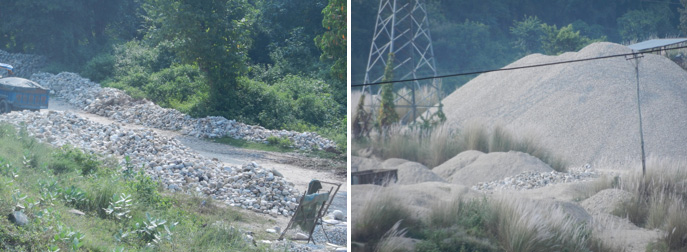The 2015 Constitution of Nepal
The 2015 Constitution has federalized administrative and governance structure of Nepal into seven provinces and 753 local units with devolution of significant authorities to provincial and local governments. The spirit of the 2015 Constitution of Nepal envisions a socialistic/mixed economy under the federalized governance. Therefore, nation’s heavy reliance on its vast natural resources for accelerated economic growth is obvious. The 2015 Constitution gives autonomy to local and provincial governments for raising and spending revenues, and they are expected to contribute and drive their planning and development processes by themselves. Federal government is responsible for planning and development of big projects such as large hydropower, multi-provincial projects, national highways, and railways. For example, in agriculture, local governments will manage local irrigation projects, agricultural roads, extension services, and livestock health; provincial governments will manage province level agriculture, livestock, and irrigation projects; and the central government will manage the issues of quarantine and large-scale irrigation projects. A close coordination with the frontline agencies and the provincial and local governments is necessary for the development of integrated national plans and their successful implementation.
The Article 51 in Section 4 of Nepal’s Constitution talks about the policies of the State. Article 51, clause “g” and sub-clauses 1-9 talk about policies relating to protection, promotion and use of natural resources in the country. Article 51 clause “l” talks about policies relating tourism development and states that priority should be given to the local people when it comes to the issue of the distribution of benefits from tourism industries. Article 51 clause “b”, sub-clause 4 guarantees good governance of natural resources with free from corruption. To facilitate policy formulations in relation to natural resources governance at the Federal level, Article 250 in Section 26 talks about the formation of National Natural Resources and Fiscal Commission (NNRFC) and Article 251 stipulates the functions, duties and powers of NNRFC. Article 251, clause 1 talks about the modality for the distribution of revenue between the Federal, Provincial and Local governments. Article 251, clause 1, and sub-clause “h” talks about investment returns in the mobilization of natural resources. Thus, the 2015 Constitution of Nepal seems to have captured the issue of the governance of natural resources at least from policy perspective. However, how effective it is in its implementation is a big question.
Sand, Gravel, and Rock Mining and the Ecological Devastation of Churia
The Churia region (or area) in Nepal consists of the Terai and the Siwalik range. The Siwalik range or the Churia hills are geologically young and are comprised of rocks and minerals that are structurally weak, have steep slopes, and have high potential for slope failures, landslides, and soil erosion. The Churia region consists of about 26.6% of the total area of Nepal and is the home for nearly 53% of the country’s population. The Bhabar areas that lie in the foothills of the Chure hills serve as the groundwater recharge zone for the Terai. The valleys in the Churia region such as Trijuga Valley, Chitwan Valley, Dang Valley, and Surkhet Valley are heavily cultivated and consist of some of the major human settlement areas of the nation. The Churia region is the home of many exotic wildlife species including tigers, rhino, crocodile, many different kind of birds, and pythons. The Churia forests consists vegetation of high economic values such as sal, khair, simal, and sisson. The Terai belt of the Churia region is the granary of Nepal. Most of the volume of international trade (both import and export) pass through the Churia region. This region hosts major dams, transit routes, industrial cities, and processing and manufacturing industries. The Churia region is culturally very diverse and is the birthplace of Nepalese luminaries such as King Janak, Lord Sita, and Lord Buddha.
 The Churia region, unfortunately, is experiencing an unprecedented level of ecological and environmental degradation due to massive deforestation, landslides, debris flow, river-cutting, and flooding in recent decades. Degradation of agricultural lands, property loss, infrastructural damage, and loss of livestock and human life due to landslides, debris-flow and flooding is a major concern. Land degradation due to landslides, debris-flow, river-cutting, flooding, and sediment deposits has become so widespread and pervasive that one can easily anticipate a complete desertification of the upper part of the Churia region in the not too distant future. With some exceptions, most Churia rivers that originate from the Chure hills contain water for only a limited duration in a year. These rivers contain an abundance of exposed rocks, pebbles, and gravel in their beds at distances up to several miles from their origin, where they literally appear as “Rock Beds”. The pictures below show a Churia river and its tributary near Hetauda. Several similar tributaries were observed a short distance away.
The Churia region, unfortunately, is experiencing an unprecedented level of ecological and environmental degradation due to massive deforestation, landslides, debris flow, river-cutting, and flooding in recent decades. Degradation of agricultural lands, property loss, infrastructural damage, and loss of livestock and human life due to landslides, debris-flow and flooding is a major concern. Land degradation due to landslides, debris-flow, river-cutting, flooding, and sediment deposits has become so widespread and pervasive that one can easily anticipate a complete desertification of the upper part of the Churia region in the not too distant future. With some exceptions, most Churia rivers that originate from the Chure hills contain water for only a limited duration in a year. These rivers contain an abundance of exposed rocks, pebbles, and gravel in their beds at distances up to several miles from their origin, where they literally appear as “Rock Beds”. The pictures below show a Churia river and its tributary near Hetauda. Several similar tributaries were observed a short distance away.
The Churia rivers have enormous power when they are flooded. The Churia rivers originate from the steep slopes of the Churia hills which are very fragile and largely composed of mudstone, gravel, and conglomerates. Soils found in the slopes and the foothills of Chure are very shallow and are underlain by rocks and gravel. In this thin soil mantle, trees, shrubs, and Chure vegetation thrives. Degraded forest land or land lacking in forest cover exacerbates runoff, soil erosion, and landslides during intense rain events which generally occur in the months of July, August and September. One can frequently observe 3-4 feet high (from the bed) flood water marks in the banks of Churia rivers. Flood waters are loaded with logs, debris, stones, sand, and wood. During flooding, the Churia rivers are capable of carrying huge boulders, large trees and stumps, and rocks for considerable distances. Once the flood water is loaded with logs, rocks, boulders, and other debris it becomes even more destructive and capable of massive river-cutting, increased sediment loads, changes in river courses, and destruction of property and infrastructure, and possible loss of human life and livestock. The Churia rivers damage agricultural lands and often sweep away villages.
Sand, gravel, and rock mining from the river beds for building and construction materials are very common activities in the region. Several Crusher Plants are operating in the region. How rock and gravel extraction activities impact river morphology, river-cutting, flooding and land degradation in the Churia region is one of the major environmental questions requiring research. The degradation of the Churia region constitutes a national level environmental and ecological crisis for Nepal. The problem of Churia degradation demands immediate attention from all concerned authorities and stakeholders to avoid catastrophic levels of irreversible environmental and ecological devastation.
For the development of effective risk reduction and mitigation programs and strategies, it is necessary to understand the geomorphology, hydrology, geology, water balance, forest conditions, socio-economic conditions, and other relevant parameters in relation to landslides, debris flow and inundation in the Churia region. Community capacity-building for risk reduction and mitigation of natural disasters is another important aspect of landscape rehabilitation. To realize these overarching goals, there should be a high level of collaboration among various governmental and nongovernmental agencies, academic institutions, local communities, and other stakeholders for this research and development. Through the implementation of appropriate strategies and measures for disaster risk reduction and mitigation in the Churia region, Nepal can reclaim hundreds of thousands of hectares of degraded land and restore ecosystem services. It will not only benefit local communities in the region in their socio-economic uplift and transformation but also will contribute the whole nation in its food security, disaster risk reduction, ecological restoration, and environmental quality.
The 2015 Constitution of Nepal includes several Fundamental Rights of Nepalese citizens. Under Section 3, among others, Right to live with dignity (Article 16), Right to freedom (Article 17), Right to equality (Article 18), Right to information (Article 27), and Right to clean environment (Article 30) are listed. As the Nepali people are struggling with massive unemployment, environmental degradation, and economic adversaries, the Government of Nepal has a historic responsibility of immediate implementation of the Constitution of Nepal pertaining to natural resources governance in an effective way in order to create employment, eradicate poverty, and rescue the country form massive ecological degradation. In part 2, the author will discuss the issue of contracts and agreements, laws and regulations, and revenue sharing in natural resources governance.
@telegraphnepal


 D. D. Poudel, the founder of the asta-ja framework-----
D. D. Poudel, the founder of the asta-ja framework----- 